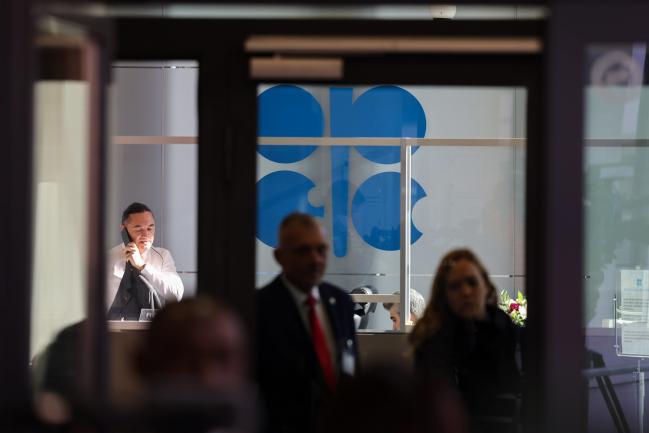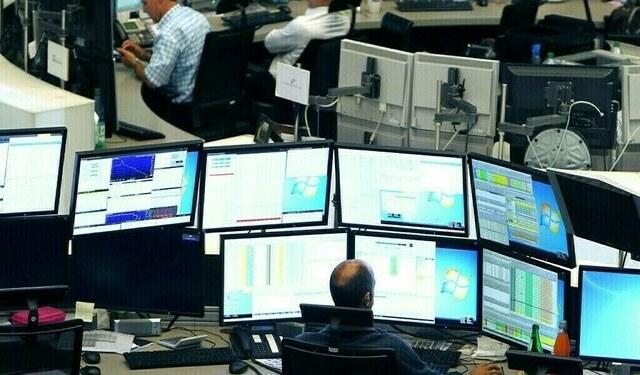
© Bloomberg. Visitors arrive at the OPEC Secretariat building ahead of the 33rd meeting of the Organization of Petroleum Exporting Countries (OPEC) and non-OPEC countries in Vienna, Austria, on Wednesday, Oct. 5, 2022. OPEC+ is considering its biggest production cut since 2020 as it tries to stabilize oil prices, a move that risks cranking up tensions with Washington.
LCO
+2.17%
Add to/Remove from Watchlist
Add to Watchlist
Add Position
Position added successfully to:
Please name your holdings portfolio
Type:
BUY
SELL
Date:
Amount:
Price
Point Value:
Leverage:
1:1
1:10
1:25
1:50
1:100
1:200
1:400
1:500
1:1000
Commission:
Create New Watchlist
Create
Create a new holdings portfolio
Add
Create
+ Add another position
Close
(Bloomberg) — Sign up for our Middle East newsletter and follow us @middleeast for news on the region.
OPEC+ agreed to cut its collective output limit by 2 million barrels a day, stoking tensions with the US as the cartel seeks to halt a slide in oil prices caused by the weakening global economy.
It’s the biggest reduction by the Organization of Petroleum Exporting Countries and its allies since 2020, but will only result in a supply reduction about half the size of the headline number. Several member countries are already pumping well below their quotas, meaning they would already be in compliance with their new limits without having to reduce production.
Even so, the decision risks adding another shock to a world that is already battling inflation driven by high energy costs. US President Joe Biden was “disappointed by the shortsighted decision” that will hurt the global economy, the White House said in a statement.
In addition to the cuts that will take effect from November, OPEC+ extended its cooperation agreement until the end of 2023. The supply curbs will remain in place until the end of next year, unless the market changes, said Saudi Energy Minister Prince Abdulaziz Bin Salman.
“OPEC wants prices around $90,” Nigerian Minister of State for Petroleum Resources Timipre Sylva said after the meeting. “It would destabilize some economies” if crude fell below that level, he said.
Oil rose as much as 2.4% to $93.96 a barrel in London, the highest in three weeks.
Earlier on Wednesday, US officials were making calls to counterparts in the Gulf trying to push back against the move to cut production, according to people familiar with the situation. President Biden has long been pushing OPEC+ to boost output, visiting Saudi Arabia earlier this year in search of lower pump prices for Americans ahead of midterm elections in November.
The White House’s national security adviser, Jake Sullivan, and National Economic Council Director Brian Deese said in a statement after the OPEC+ meeting that the US would release another 10 million barrels of oil from the Strategic Petroleum Reserve in November, and that “the president will continue to direct SPR releases as appropriate to protect American consumers and promote energy security.”
Real Cuts
The cut of 2 million barrels a day will be measured against the same baseline as the previous OPEC+ agreements, Amir Hossein Zamaninia, OPEC governor for Iran, told reporters in Vienna after the meeting. Shared pro rata between members, that would require just eight countries to curb actual production and deliver a real reduction of about 900,000 barrels a day, according to Bloomberg calculations based on September output figures.
OPEC+ will no longer hold monthly meetings, Zamaninia said. The group’s Joint Ministerial Monitoring Committee, which oversees implementation of production cuts, will meet every two months, he said.
The supply curbs may not have the result OPEC+ is hoping for, said Ole Hansen, head of commodity strategy at Saxo Bank A/S.
“Cutting production at this time has been a bit of mystery to me given the fact the price has not fallen much below the $90-100 Brent range that seems to be acceptable to most producers,” Hansen said. “This decision risks agitating the US while potentially leading the FOMC to keep tightening for longer as inflation will become more sticky. The result being a stronger dollar, higher bond yields and a global economic slowdown that may end up taking longer to reverse.”
(Updates with comment from Saudi energy minister in fourth paragraph.)
©2022 Bloomberg L.P.
Source: Investing.com


























